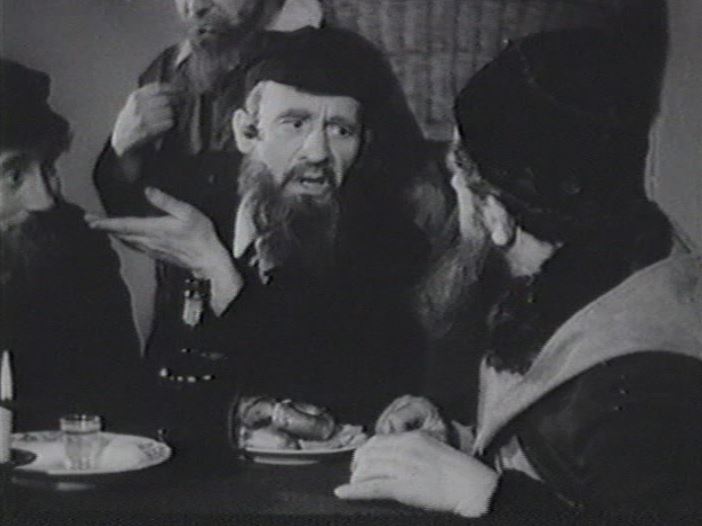

Pre-dating the classic Der Dybbuk by four years, this film tells the same tale of frustrated love and destiny, as well as the breaking and fulfilling of vows. A yeshiva student and an orphan girl who are deeply in love face eternal separation even though their parents promised each to the other before birth. Only the miraculous intervention of a prophet will allow their parents to fulfill their vow.
Wilno (1936) + Jewish Life in Vilna (1939):
The main feature is followed by this nine-minute film (with English narration) about Jewish life in Vilna, made shortly before the outbreak of the Second World War. Interestingly enough, the film is actually entitled Jewish Life in Wilno; "Wilno" was the Polish name for the city. The film following this one, also nine minutes in length, is an UfA Kulturfilm entitled Wilna, the German name for the city. Filmed in 1936, during a period of relative cooperation on a political level between Nazi Germany and Poland -- with the former looking to entice the latter into an anti-Soviet alliance -- the movie concentrates almost entirely on Polish life and institutions in the city and, understandably, only very briefly shows the former Jewish ghetto.
By the time both films were made, Vilnius was firmly in Polish hands. At the end of the First World War, as the Germans started pulling out of occupied Lithuania, Polish self-defence units briefly took control of the city before being driven out by invading Soviet forces in 1918. During the subsequent Polish-Soviet War and the Lithuanian Wars of Independence, the city was taken by the Polish Army only to fall to the Soviets once again as they advanced on Warsaw. When the Soviets' advance was finally stopped outside of Poland's capital, the Russians, in a bid to stall a Polish counteroffensive, ceded Vilnius to Lithuania in a July, 1920 treaty. At the conclusion of hostilities between all the parties involved, both Poland and Lithuania sought to annex Vilnius to their respective countries. The League of Nations got involved in the conflict and while Vilnius and its environs were not specifically mentioned in the Suwalki Agreement of October, 1920, most historians have concluded that Vilnius was to be ceded to Lithuania. The point was made moot, when, on 09 October 1920, Polish forces surrpetiously seized the city and created an independent state: The Republic of Central Lithuania. Due to the city's overwhelming Polish population (only about 6% of the city's population was Lithuanian), as well as a large Jewish minority (roughly 33%), the 1922 elections led to the city and its environs' annexation by the Polish state. Kaunas became the temporary capital of Lithuania and from that point until the end of the Second World War, relations between the two countries were practically non-existent, with border crossings being shut down, telephone lines and roads being cut and blocked at border points, and even mail service between Lithuania and Poland being suspended (all actions initiated and executed by the Lithuanians). Wuth the exception of Lithuania, the rest of the diplomatic community recognized Polish sovereignty over Vilnius in 1923.
Each community had its own name for the city: the Poles named it Wilno; the Jews, Vilne; and the Lithuanians, Vilnius. Making up about a third of the city's population, the Jews played an important part in the city's history, though, as in most of Eastern Europe, assimilation and intermingling with their non-Jewish neighbors was quite limited. Vilna was known as the "Jerusalem of Lithuania" by the world's Jews.
On 19 September 1939, two days after the Soviets marched into their agreed-upon zone of occupation of Poland, the Red Army marched into Vilnius. Shortly thereafter, the Lithuanians concluded a rather one-sided treaty with the USSR recognizing the right of the Soviet Union to establish military bases on Lithuanian territory (or face full invasion in the face of refusal). Once that treaty was concluded, the Red Army withdrew to bases in Vilnius' suburbs and Lithuania took possession of the city and its environs, given to it by the Soviet government. With a ceremonial parade by the Lithuanian Army in the city centre, the policy of forced Lithuanization began, mainly targeting Polish schools and governmental organizations and banning the use of Polish. This Lithuanization lasted until August, 1940, when the Soviets occupied all of Lithuania following a June ultimatum from the Soviets demanding, among other things, that unspecified numbers of Red Army soldiers be allowed to enter Lithuania for the purpose of forming a government more friendly to the USSR. After annexing the country, Vilnius became the capital of the newly-created Lithuanian SSR and some 25,000 inhabitants of the city were subsequently arrested by the NKVD and deported to the far eastern parts of the Soviet Union.
Two days after the German invasion of the USSR on 22 June 1941, Vilnius was captured by the advancing Wehrmacht. Two ghettos were set up in the Old Town center for the city's large, Jewish population. The smaller one was liquidated by October. The larger ghetto lasted until 1943, though, like Warsaw, its inhabitants were regularly deported in Aktionen and executed at the nearby Ponary Forest. The ghetto was finally liquidated in September, 1943 after a failed uprising against the Fascist occupiers and their helpers. By war's end, 95% of the country's Jews had been murdered.
DVD-R is in English without subtitles. Approx. 58 mins. + two, 9 min. films. 




